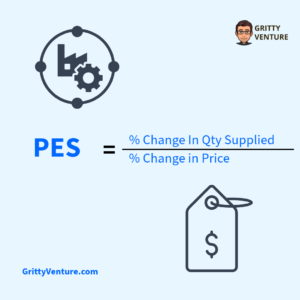Ever wondered why some products can quickly flood the market while others take ages to appear on shelves? That’s where the concept of elasticity of supply comes in. Whether you’re a business owner, an economics enthusiast, or just someone curious about how markets function, understanding the elasticity of supply can give you a new perspective on pricing, production, and availability of goods.
In this blog post, we’ll break down what elasticity of supply is, why it matters, what factors influence it, and how businesses and governments use this concept to make informed decisions. Let’s dive in!
What Is Elasticity of Supply?
Elasticity of supply refers to how much the quantity of a good or service supplied changes in response to a change in price. In simple terms, it’s a measure of how quickly and easily producers can ramp up or slow down production when prices fluctuate.
Mathematically, it’s expressed as:

Generally speaking, the price elasticity of supply will always be a positive number. This is because there is always a positive supply impact to higher prices unless you are in one of the rare cases like art sales where the artist is no longer living.
If the result is greater than 1, the supply is considered elastic (producers can easily adjust output). If it’s less than 1, the supply is inelastic (production adjustments are difficult). When it equals 1, supply is said to be unitary elastic (supply changes at the same rate as price).
Types of Elasticity of Supply
1. Perfectly Elastic Supply
- Even a tiny price increase leads to an infinite rise in the quantity supplied.
- Rare in real life but can happen in highly competitive markets with minimal production costs.
2. Elastic Supply
- Supply responds significantly to price changes.
- Common in industries where production can be quickly scaled up, like textiles or manufactured goods.
3. Unitary Elastic Supply
- The percent change in supply matches the percentage change in price.
- Rare but serves as a theoretical benchmark.
4. Inelastic Supply
- Even with a price increase, supply doesn’t increase much.
- Found in industries where production takes time (e.g., wine production, housing).
5. Perfectly Inelastic Supply
- Supply remains the same regardless of price.
- Example: Unique paintings by famous artists (only one original exists).
Factors That Affect Elasticity of Supply
1. Time Horizon
- In the short run, supply is often inelastic because producers need time to adjust.
- In the long run, supply becomes more elastic as businesses adapt and expand.
2. Availability of Resources
- If raw materials and labor are readily available, supply is more elastic.
- Scarcity of resources makes supply less flexible.
3. Production Flexibility
- Industries with modular or scalable production (like software) have higher elasticity.
- Capital-intensive industries (like mining) tend to be inelastic.
4. Storage Capacity
- If a product can be stored easily (like canned goods), supply can respond more flexibly to price changes.
- Perishable goods (like fresh vegetables) have lower elasticity.
5. Barriers to Entry
- If new firms can easily enter the market, supply tends to be more elastic.
- Strict regulations and high setup costs make supply inelastic.
Real-World Examples of Elasticity of Supply
Below are a number of examples of how businesses in the real world adjust their supply to changes in price.
Elastic Supply: Fast Fashion Industry
Fast fashion brands like Zara and H&M can quickly ramp up production when demand rises because they have efficient supply chains, rapid production cycles, and easy access to raw materials. Their ability to forecast fashion trends, work with flexible manufacturers, and leverage global logistics allows them to quickly introduce new designs to the market. Since they operate on short production cycles, they can easily respond to changing consumer preferences and price fluctuations.
Inelastic Supply: Housing Market
Even if home prices skyrocket, new housing developments take time due to permits, construction, and labor shortages, making housing supply relatively inelastic in the short term. Government regulations, zoning laws, and lengthy approval processes further restrict the ability to rapidly increase housing supply. Additionally, the construction industry faces material shortages, skilled labor constraints, and financing challenges that limit its capacity to respond swiftly to price increases.
Perfectly Inelastic Supply: Limited Edition Collectibles
A signed Michael Jordan rookie card has a perfectly inelastic supply because no new originals can be produced—its supply remains fixed regardless of demand. The same applies to rare art pieces, vintage cars, and historical artifacts. Since these items are unique and cannot be reproduced, their supply remains constant, making their prices subject entirely to demand fluctuations. As a result, high demand can push prices to astronomical levels, as seen in auctions for rare collectibles.
How Businesses Use Elasticity of Supply
Understanding supply elasticity helps businesses make better production and pricing decisions. Here’s how:
1. Adjusting Production Strategies
- Businesses with elastic supply can quickly increase production when prices rise, maximizing profits.
- Those in inelastic industries must carefully plan long-term investments to avoid losses.
2. Setting Prices
- If supply is elastic, businesses might lower prices to drive up sales without fear of running out of stock.
- If supply is inelastic, they might maintain higher prices knowing they can’t easily increase production.
3. Managing Inventory
- Elastic supply industries benefit from just-in-time (JIT) inventory systems.
- Inelastic supply industries must ensure they have adequate stock to meet potential demand shifts.
Government Policies and Elasticity of Supply
Governments also use supply elasticity insights to shape policies that ensure economic stability and market efficiency. Here are some ways:
1. Taxation
- If supply is inelastic, taxes tend to be passed onto consumers.
- Elastic supply means producers might absorb some of the tax burden.
2. Subsidies
- Governments provide subsidies to encourage production in industries with inelastic supply (e.g., agriculture) to prevent shortages.
- Industries with elastic supply often don’t need subsidies as they adjust quickly.
3. Regulating Essential Goods
- During crises (e.g., pandemic-related shortages), governments may enforce price controls or incentivize increased production.
4. Encouraging Market Entry
- By reducing barriers to entry, governments can increase supply elasticity, ensuring competitive markets and stable prices.
Bringing It Home
Elasticity of supply is a crucial concept that influences everything from product availability to pricing strategies and government policies. Understanding whether an industry has elastic or inelastic supply can help businesses make better decisions and help consumers predict how markets will react to changes in demand and price.
To sum up:
- Elastic supply = Quick response to price changes.
- Inelastic supply = Slower adjustment, often due to production constraints.
- Time, resources, flexibility, storage, and market entry all play key roles.
So next time you see prices fluctuate or wonder why some products are always available while others take forever to restock, you’ll know that elasticity of supply is at play!
What’s your take on this? Have you noticed any products that seem to have highly elastic or inelastic supply? Share your thoughts in the comments below!



